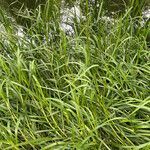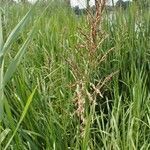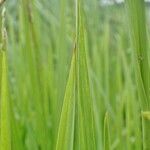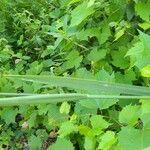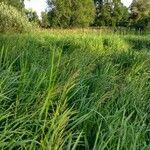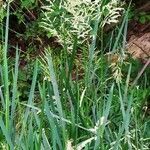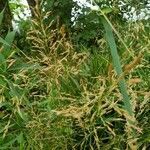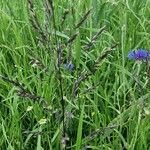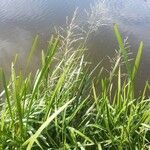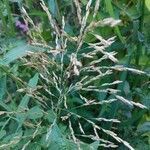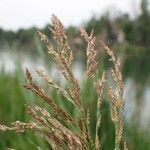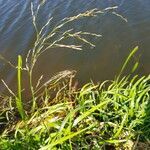Robust rhizomatous and often reed-like perennial, sometimes rooting at lower nodes. Culms erect, to 250 cm high. Leaves: sheaths indistinctly cross-veined (often apparent only on abaxial surface); ligule 3–7 mm long, obtuse or truncate (often with a short central point), remaining intact; blade 22–60 cm long, 7–20 mm wide, indistinctly cross-veined, adaxially smooth or scabridulous. Inflorescences much-branched panicles, open or loosely contracted, 12–45 cm long. Spikelets elliptic, 5.5–12 mm long, with 3–6 (–10) bisexual florets; rachilla papillose or scabrous. Glumes oblong or ovate, obtuse to acute, 1-nerved; lower glume 2–3 mm long; upper glume 2.8–4 mm long. Lemma ovate or elliptic, 2.5–4 mm long, obtuse (rounded when opened), entire, often weakly keeled, scaberulous. Palea shortly exceeding lemma, usually apically notched, papillose. Anthers 1.5–2 mm long. Caryopsis dorsiventrally compressed, not grooved.
Perennial, rhizomatous; rhizomes long, thick. Culms stout, erect, 80–200 cm tall, up to 10 mm in diam. Leaf sheaths smooth or scabrid toward blade; leaf blades flat, light green, 25–50 cm × 8–16 mm, with transverse veinlets, abaxial surface scabrid, adaxial surface smooth or sparsely scabrid, apex acute; ligule 2–4 mm. Panicle ovate to oblong in outline, usually laxly contracted, 20–40 cm, exserted, spikelets many; branches 4–10 per node, obliquely ascending, relatively thick, scabrid. Spikelets narrowly oblong, 5–12 mm, florets 5–10, yellowish green or purple tinged; rachilla internodes smooth; glumes narrowly ovate, 1-veined, lower glume 2–3 mm, upper glume 3–4 mm, subacute; lemmas oblong, 3–4 mm, thinly herbaceous, 7-veined, veins scabrid, apex membranous, broadly obtuse; palea as long as lemma, keels wingless, scabrid. Stamens 3, anthers 1.2–1.8 mm. Fl. May–Jul. 2n = 28, 56, 60.
Robust, erect perennial 900-2500 mm high; rhizomes stout, spreading; culm stout to robust. Leaf blade 300-600 x 7-20 mm, abruptly pointed, margins rough, cross nerves sometimes present (may not be easy to see) on the lower surface. Inflorescence 150-450 mm long, open or becoming contracted and dense, broadly ovate to oblong, much branched, branches clustered, rough. Spikelet 5-12 x 2.0-3.5 mm, 4-10-flowered, green or tinged with yellow or purple, slightly compressed; glumes 1-nerved, lower 2-3 mm long, upper 3-4 mm long; lemma 3-4 mm long, apex very obtuse, membranous, prominently 7-nerved, nerves minutely scabrid; palea ± equal to lemma, keels hairy; anther (1.0-)1.5-2.0 mm long; caryopsis 1.5-2.0 mm long, dark brown, ellipsoid.
A grass.
